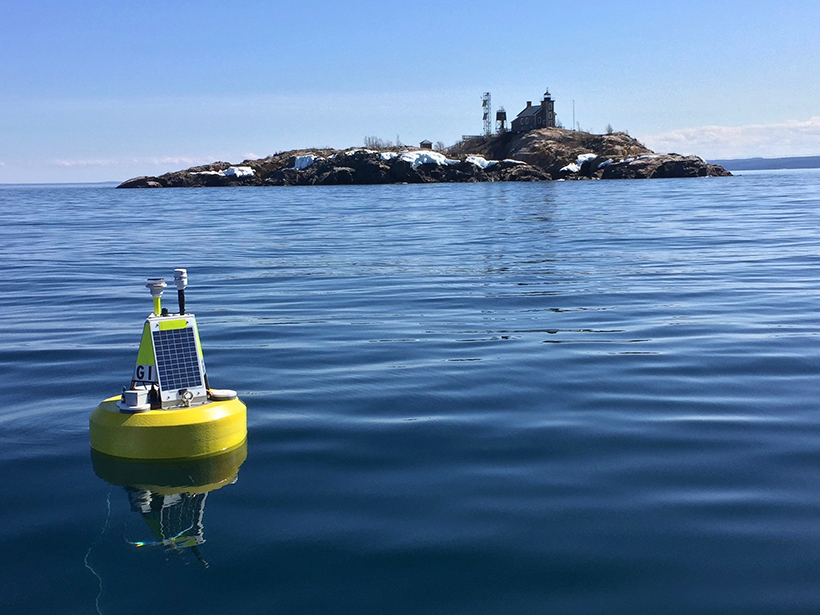The winter of 2015–2016 witnessed one of the strongest El Niño events on record. Typical El Niño winters are warm in the Great Lakes region of the United States, with below-normal ice cover and warm water temperatures during the subsequent summer. This past winter was no exception, with record-high air temperatures observed in the Upper Midwest from October through December 2015 and less than 7% total ice cover on the Great Lakes through early February. The strongest previous El Niño occurred in 1997–1998 and was associated with a regime shift in Lake Superior ice cover, water temperature, and evaporation, followed by a rapid decline in lake level.
How well can we forecast—from the physics to the fish—the effects of the 2015–2016 El Niño on subsequent summer and fall conditions in Lake Superior?
In the interest of improving Great Lakes ecosystem forecasting capabilities, the University of Michigan and the Cooperative Institute for Limnology and Ecosystems Research (CILER), a National Oceanic and Atmospheric Administration cooperative institute located at the university, hosted a 2-day summit in May 2016. Participants included more than 30 representatives from universities, government labs, private industry, and nonprofit organizations with expertise in a range of topic areas, including biogeochemistry, climate science, ecology, hydrology, lake physics, and remote sensing. The goal of the summit was to help set future research priorities for Great Lakes observations and models to improve our ability to predict the lakes’ response to environmental change.
Workshop organizers sought to capitalize on this past winter’s strong El Niño event by posing a “Superior Challenge” to Great Lakes researchers: How well can we forecast—from the physics to the fish—the effects of the 2015–2016 El Niño on subsequent summer and fall conditions in Lake Superior? Organizers chose Lake Superior as the focus of the summit to keep the problem tractable, as well as to take advantage of the fact that this lake has large thermal memory, a strong sensitivity to climate change (e.g., rapid warming of surface water temperature), and a growing availability of models and observations.
Five interdisciplinary breakout groups discussed three topics over the course of the summit:
- Current Knowledge and Confidence: How much is currently known in each topic area, and how confident are we in that knowledge?
- The Forecast: What are our predictions for Lake Superior in subsequent seasons, and how confident are we in these predictions? How will the forecast be validated? What resources are needed?
- Gaps in Observations, Modeling, and Understanding: What major research gaps are limiting our ability to forecast lake ecosystem response to environmental change?
Workshop attendees noted that in addition to long-term trends, year-to-year variability in such factors as ice cover, water temperatures, and lake levels on the Great Lakes appears to be increasing. They identified this as a challenge because Great Lakes observations, scientific understanding, and predictive tools are not keeping pace.
Year-to-year variability in ice cover, water temperatures, and lake levels on the Great Lakes appears to be increasing, but observations, scientific understanding, and predictive tools are not keeping pace.
Participants agreed that there are opportunities to apply simple models (with fewer propagating errors than more complex models) to make reasonably robust 3- to 6-month forecasts of lake phenology (e.g., timing of stratification, onset of evaporation), but taking advantage of these opportunities will require increased investment in resources to develop comprehensive ecosystem forecasting models for the Great Lakes. These resources should include greater availability of high-quality, year-round observations over and within the lake to drive models and quantitatively predict and validate the effects of extreme events such as the 2015–2016 El Niño event.
A summary of the workshop outcomes and recommendations is being prepared and will be posted on the CILER website. For more information on the Superior Challenge Summit, please contact CILER’s program manager, Mary Ogdahl, at [email protected].
—John D. Lenters (email: [email protected]) and Peter D. Blanken, Department of Geography, University of Colorado, Boulder; and Branko Kerkez, Department of Civil and Environmental Engineering, University of Michigan, Ann Arbor
Citation:
Lenters, J. D.,Blanken, P. D., and Kerkez, B. (2016), Predicting a Great Lake’s response to a warm winter, Eos, 97, https://doi.org/10.1029/2016EO062499. Published on 11 November 2016.
Text © 2016. The authors. CC BY-NC-ND 3.0
Except where otherwise noted, images are subject to copyright. Any reuse without express permission from the copyright owner is prohibited.

